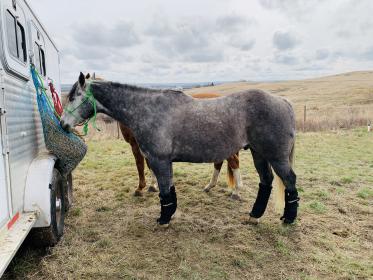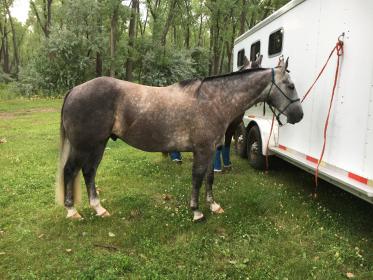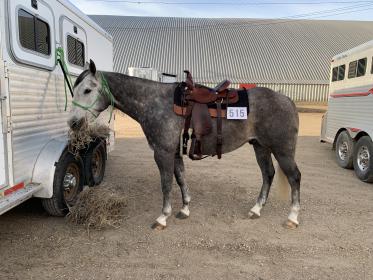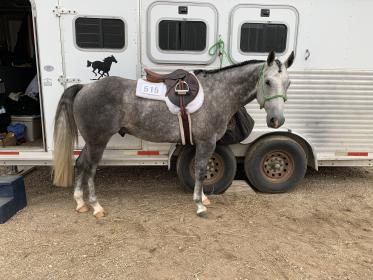22 yr old thoroughbred of mine, dressage horse by training, was diagnosed with issues C5-C7. Symptoms were initially inability to hold the correct lead in canter; would swap behind. Also didn’t do terribly well on the tail pull and similar neuro tests. Vet did injections (yes, ultrasound) 3 on each side of neck. Gave him a couple weeks rest and he was quite fine. The injections helped for a yearor so, though I was not doing any real upper level dressage; just a relaxed, training level frame, allowing him to stretch out the neck and back. Then I started noticing an occasional slipping of his one stifle - very random, not every ride. Over the course of the next 4-5 months, slow increase in the frequency of the slipping. So I quit riding him. I did put him in our round pen maybe once/twice a week to watch him move; it did not happen when there was no tack/weight on him.
One thing my vet said at the time was that in his experience a second time around with injections was less successful both in terms of improvement and duration of that improvement, so I did not do them again; I did keep him on equioxx for quite a while. By 25 he was clearly showing signs of decline though I actually put him down for an unrelated issue.
By the way, thanks for all your stories. 
First attachment (where he is wearing the BOT wraps) is a decent conformation picture I have from last year (2019). He’s still a bit wooly as it was taken in the spring.
Second attachment is another nice confo picture I found on my computer from 2018.
I figured these were better than any I got tonight on slanted ground in awkward positions. :o Foot pictures didn’t seem to look much better, but I was rushing trying to get rides in after work before it got dark.


Mine is similar to what 2tempe describes—only she is much younger (which is what concerns me). As a 3 year old, she had a lovely temperament and trot—and had the typical 3 year old canter (learning how to balance with a rider on her back). I thought as she matured, the canter would improve. At age 5 she still struggled to maintain the canter for very long and would sometimes swap behind. If I pushed her on—she would get tight in the neck and be very anxious. It’s a weird feeling—like she wants to hold herself in one position—and is defensive about me asking her to use her neck at ALL, in the canter. Whereas—at the trot, she is soft in the neck and is happy with contact. Most of the time after even a short canter, she would have fast, shallow breathing like she was stressed. Swapping behind and struggling in the canter seemed to point to SI, hock, or stifle issues. However, all were evaluated by vets and found nothing. Also did neuro tests —and vets saw nothing there either. When they took rads of the neck—found moderate arthritic changes at C-5-6-7. They injected her neck and after that I finally started to get a “normal” feeling canter from her. The anxiety went away and she was able to maintain the canter longer and the swapping behind went away completely.
After about 1.5 years—I started to feel like her canter was a struggle again. She was falling back into trot after a short canter and started swapping behind at times. And she started “holding” her neck again in the canter—as well as the anxiety about cantering and shallow, quick breathing afterwards. Meanwhile, her trot is still making progress and we are schooling levels above where we are at the canter. So I feel like her neck pain is related to the “up an down” motion of the neck in the canter, and the trot is not painful for her because the neck doesn’t need to move (in the C 6-7 area) in the trot. I tried doing a course of Adequan to see if that would help—but it didn’t. So I got her neck injected again a few weeks ago. She is starting to feel better again. I requested they do more rads of the neck and the good news was there wasn’t much change from 2 year ago. But it also told me that she is clearly uncomfortable without the injections.
I am not sure what will happen long term with her. I worry about it progressing and she starts having neuro issues. I’m just not super hopeful that we will be able to make progress with her neck issues, especially after reading some of these posts! Why does it always seem to be the ones with wonderful temperaments that have the health issues? .
I am in the exact same boat as you, so I feel your pain! My 3-year old has the best brain, is eager to learn and brave as hell. Hoping to pursue a hunter/jumper career with her but the future is uncertain. We recently had her neck injected for the same reasons (changes in C6 - 7) along with shockwave and OsPhos. It gives me a little bit of reassurance that you got a solid 1.5 years out of your first injection. Jingles for you and your girl.
Hugs to you…
What are you doing management wise? It can help. My horse with CA needs to be out 24/7. If he is stalled any length of time, you can tell when you ride him - as he is stiff, when he is not naturally so when you’re riding him any other time.
Another thing I have seen that is just a suspicion and in no way fact, but, I’ve had three horses with neck issues at this point in my horse owning life - all of them hated eating from a hay net - as in they would leave a full hay net and just not eat it. If you are feeding through means like that it may be worth investigating if it can be fed on the ground or loose.
Have you tried pentosan? It helped one of my first horses with CA significantly.
Finally – how are the feet…? I know I sound like a broken record, but it really impacts how they move and their neck.
I still can’t see well enough, but what I do see would have me looking at the hind feet more.
In general, with the cannon bone vertical, you want to draw a line along the coronet band and continue it forward, and ideally it should hit somewhere between the girth area/elbow. Some horses have naturally more upright hinds, or shorter back
In this case, that RH looks like that line will hit well behind the girth, meaning, there’s too much angle which means low heels (relative to toes).
I will be traveling this weekend with my mom with the horses. I am hoping to get some better feet pictures then, at least on gravel or packed dirt or something that is more appropriate for viewing hoof photos. And helps to have a helper hold said horse still!
So JB, are you referring to the hind feet in terms of the toe dragging?
Or that it is or isn’t a neck issue, for the front feet tripping?
Just trying to understand what exactly you are saying.
I dug through some more pictures. Not a perfect confo shot with his western saddle on, but maybe shows the feet decent?? It was taken in May of last year (2019). Please don’t mind his stuffing his face with hay!
sidenote - I did not put front shoes on him last year for 2019*
And another one from June 2019 with his English saddle on. I realize he’s got one rear foot too far forward and the other too far back, but maybe you can take an average. :lol:


Yes
Or that it is or isn’t a neck issue, for the front feet tripping?
Just trying to understand what exactly you are saying.
I don’t know if there’s a neck issue
I dug through some more pictures. Not a perfect confo shot with his western saddle on, but maybe shows the feet decent?? It was taken in May of last year (2019). Please don’t mind his stuffing his face with hay!
sidenote - I did not put front shoes on him last year for 2019*
And another one from June 2019 with his English saddle on. I realize he’s got one rear foot too far forward and the other too far back, but maybe you can take an average. :lol:
The LH still looks questionable to me, the RH still looks like its ok.
Well, I figured it’s time to revive the thread as I’m starting to dig again on getting him to feel better.
We were at the vet last week to xray his back. Looked pretty good for the most part. Only one spot where there was some slight change and/or narrowing of the space but not too bad. Certainly isn’t on top of the list but something to keep in mind.
I’ve just started to ride him consistently again to get him in shape for the year (very light riding over the winter) and he was palpating pretty muscle sore despite. I have sent hair in to AQHA for a genetic panel but haven’t gotten results yet. I exercised him the morning of the vet appt and she drew blood to check for elevated enzymes, which all came back normal.
I spoke with my farrier 2 weeks ago about his hind feet. We’re going to kind of table it for the moment but we don’t have any reason to believe he has anything wrong with them, but if things aren’t clearing up, I will have my vet xray his back feet to see what his angles should be, but I want to try to address one thing at a time.
We decided to inject his neck, based on his rads from last fall and based on his exam last week. Still so stiff! We just both feel that’s not right. When he turns his head to the side, he leads with his nose and tips his head funny. Like he just can’t. He’s also gotten worse with the nose throwing, which I think he’s doing because something is hurting.
So she injected C3, C4, and C5 and we also gave him Osphos.
We’re set up to see an osteopath?? on Saturday. (If I am remember her title correctly.) Something new for me but she is highly recommended.
And then after that I’ll get my chiro to work on him too.
And we’re already set up with the vet in about a month to evaluate how the neck injections are working and if there is anything else we should do for him.
I did also have her xray his hocks since it had been a while. Super small changes compared to last time but there is some change. So hock injections might be warranted at the next visit, pending on how he is doing. We will see.
I’m not sure what supplement I’ll try this year. I had him on Adequan last year which didn’t prevent any soreness. I’ve had him on Pentosan all winter, and I don’t feel like I have noticed any difference with the tripping and/or nose throwing. I suppose I could try Summit but I think I want to wait anyway to see how the Osphos might turn out.
Jingles that I get my poor horse figured out!
Well darn, maybe I shouldn’t have updated.
My vet got correspondence from a neck expert she sent his rads too. It’s not good. Long story short, he most likely has spinal cord compression due to narrowing of the spinal canal because of significant structural asymmetry (one of the facets of each vertebrae are positioned more cranially than the other facet).
The neck injections we did might help if he has synovial effusion, to reduce the inflammation and take some pressure off the cord. If the injections don’t help at all, then he likely has some spinal cord compression. Small chance that he just has pain due to the structural assymmetry (and not compression) but in my own opinion, I feel that that is not likely.
Specialist doesn’t have the ability to do full imaging at her facility to confirm but offered one that could. At this point, I don’t think it’s worth it. I feel like the diagnosis is pretty undeniable.
I’m crushed. And I can’t do anything for the poor boy. He’s only 10. And sooooo talented.
I’m throwing my sucker in the dirt…
I’m so sorry  I had to euthanize a young horse last year due to neck issues like that. It’s so hard. My heart goes out to you.
I had to euthanize a young horse last year due to neck issues like that. It’s so hard. My heart goes out to you.
I’m so sorry. Neck issues are heartbreaking and seem to be getting more prevalent. Or we are diagnosing them better.
Hi slp2,
Do you have any updates from this post? Your description of your mare’s canter (tight neck, anxious, not flexible) but willingness to trot is similar to my gelding. Although, no breathing changes. I am on month 4 ($$$$) of trying to figure out what is wrong and just had his neck injected today at C3-4, C4-5, and C5-6.
My guy kicks out / bucks at the canter if I have a saddle on. He is much better if I ride with a bareback pad. He has been competing and in steady work for 4 years, although with lots of recent rest as we complete all of these diagnostics. Saddle fitter came and I purchased new saddle; bone scan showed nothing; No EPM after bloodwork test; blocked up the joints on back legs with no changes; ulcers found and treated; SI’s injected with no change; hocks injected with no change; X-rays show no changes whatsoever on spine… I am probably forgetting a few other items we have tried with no luck.
Will be interesting to see the results of neck injections. Did your vet do neuro tests? Have you seen any tripping? Just fyi, cervical injections can do wonders if that is the problem. But its a bit of a crapshoot as to how long they will last. And there is anecdotal evidence that if you do them a second time, they often don’t work nearly as well. You might also test for Lyme if you haven’t already.
Hello! An update on this mare. I retired her at age 9 and she is happily hanging out. Never showed any signs of neurological issues. Always good for trailering, shoeing (holding up hinds etc) but never comfortable cantering under saddle. I had other vets evaluate her and did try some other modalities, but never found any other clear answers other than the CA. And the fact that the initial neck injections helped her so much— makes me think that was the problem. Unfortunately, the injections only helped for a short time and additional injections did not yield the same results (I did have her injected 3 times). At a certain point I decided to give up and just move on. I was tired of chasing down expensive diagnostic rabbit holes and tired of dashed hopes when new treatments never worked.
The thing is— she looks and moves fine out in the pasture with no weight on her back. Although I’m absolutely sure she has learned to compensate for her physical issues and doesn’t push her athletic abilities.
Good luck with your horse — sorry I didn’t have a more positive update.
What was your horse’s hind end lameness symptoms?
It started with a super subtle hind end “hitch”. Over time it did get worse and she toe-dragged a bit with the one hind. Only ended up finding the culprit after a bone scan.
What was the culprit?! My vet is recommending an MRI on one leg but not I’m curious if it might be better to just do a bone scan.
She ended up being diagnosed with a bone lesion between C6/C7 vertebrae. We threw everything at it to make it go away/make her comfortable but unfortunately, we had to retire her.
So sorry to hear that she had to be retired despite your best efforts. Horses are truly heart breaking. I’m going to ask for neck x rays to at least rule it out even though not a single vet out of the 4 she has seen has suggested it.
